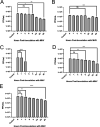Murine Hepatitis Virus, a Biosafety Level 2 Model for SARS-CoV-2, Can Remain Viable on Meat and Meat Packaging Materials for at Least 48 Hours
- PMID: 36069589
- PMCID: PMC9603800
- DOI: 10.1128/spectrum.01862-22
Murine Hepatitis Virus, a Biosafety Level 2 Model for SARS-CoV-2, Can Remain Viable on Meat and Meat Packaging Materials for at Least 48 Hours
Abstract
In 2020 and 2021, many meat processing plants faced temporary closures due to outbreaks of COVID-19 cases among the workers. There are several factors that could potentially contribute to the increased numbers of COVID-19 cases in meat processing plants: the survival of viable SARS-CoV-2 on meat and meat packaging materials, difficulties in maintaining workplace physical distancing, personal hygiene, and crowded living and transportation conditions. In this study, we used murine hepatitis virus (MHV) as a biosafety level 2 (BSL2) surrogate for SARS-CoV-2 to determine viral survival on the surface of meat, namely, stew-cut beef and ground beef, and commonly used meat packaging materials, such as plastic wrap, meat-absorbent material, and Styrofoam. From our studies, we observed the infectivity of MHV inoculated on ground beef and stew-cut beef for 48 h and saw no significant loss in infectivity for MHV from 0 to 6 h postinoculation (hpi) (unpaired t test). However, beginning at 9 hpi, viral infectivity steadily decreased, resulting in a 1.12-log reduction for ground beef and a 0.46-log reduction for stew-cut beef by 48 hpi. We also observed a significant persistence of MHV on meat packaging materials, with Styrofoam supporting the highest viability (3.25 × 103 ± 9.57 × 102 PFU/mL, a 0.91-log reduction after 48 hpi), followed by meat-absorbent material (75 ± 50 PFU/mL, a 1.10-log reduction after 48 hpi), and lastly, plastic wrap (no detectable PFU after 3 hpi, a 3.12-log reduction). Despite a notable reduction in infectivity, the virus was able to survive and remain infectious for up to 48 h at 7°C on four of the five test surfaces. Our results provide evidence that coronaviruses, such as SARS-CoV-2, could potentially survive on meat, meat-absorbent materials. and Styrofoam for up to 2 days, and potentially longer. IMPORTANCE The meat industry has been faced with astronomical challenges with the rampant spread of COVID-19 among meat processing plant workers. This has resulted in meat processing and packaging plant closures, creating bottlenecks everywhere in the chain, from farms to consumers, subsequently leading to much smaller production outputs and higher prices for all parties involved. This study tested the viability of meat and meat packaging materials as potential reservoirs for SARS-CoV-2, allowing the virus to survive and potentially spread among the workers. We used murine hepatitis virus (MHV) as a biosafety level 2 (BSL2) surrogate for SARS-CoV-2. Our results suggest that ground beef, stew-cut beef, meat-absorbent material, and Styrofoam can harbor coronavirus particles, which can remain viable for at least 48 h. Furthermore, our study provides evidence that the environmental and physical conditions within meat processing facilities can facilitate the survival of viable virus.
Keywords: MHV; SARS-CoV-2; meat; packaging material.
Conflict of interest statement
The authors declare no conflict of interest.
Figures

References
-
- World Health Organization. 2022. Coronavirus disease (COVID-19): food safety and nutrition. https://www.who.int/news-room/questions-and-answers/item/coronavirus-dis....
-
- Jeffers SA, Tusell SM, Gillim-Ross L, Hemmila EM, Achenbach JE, Babcock GJ, Thomas WD, Thackray LB, Young MD, Mason RJ, Ambrosino DM, Wentworth DE, Demartini JC, Holmes KV. 2004. CD209L (L-SIGN) is a receptor for severe acute respiratory syndrome coronavirus. Proc Natl Acad Sci USA 101:15748–15753. doi: 10.1073/pnas.0403812101. - DOI - PMC - PubMed
Publication types
MeSH terms
Substances
LinkOut - more resources
Full Text Sources
Medical
Miscellaneous

